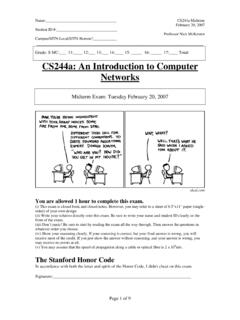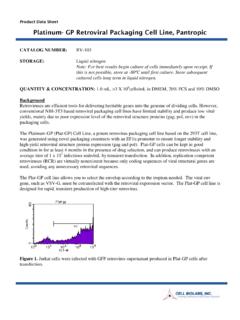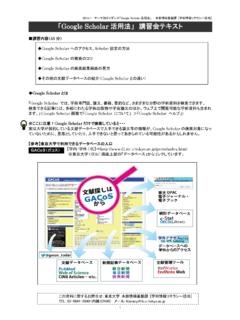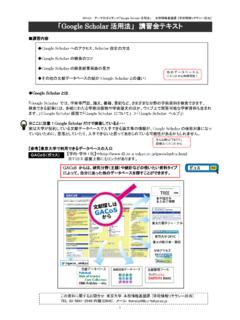Transcription of Reprogramming to a muscle fate by fusion …
1 Research Article 1045. Reprogramming to a muscle fate by fusion recapitulates differentiation Jason H. Pomerantz*, , Semanti Mukherjee , Adam T. Palermo and Helen M. Blau*. Baxter Laboratory in Genetic Pharmacology, Departments of Microbiology and Immunology, Stanford University School of Medicine, Stanford, CA. 94305, USA. *Authors for correspondence (e-mails: . Present address: Department of Surgery, Division of Plastic and Reconstructive Surgery, University of Washington, Seattle, WA 98195, USA.. Present address: Cancer Biology and Genetics Program, Memorial Sloan Kettering Cancer Center, New York, NY 10065, USA.. Present address: Genzyme Corporation, Framingham, MA 01701, USA. Accepted 25 November 2008. Journal of Cell Science 122, 1045-1053 Published by The Company of Biologists 2009.)
2 Summary fusion of mammalian cells to form stable, non-dividing the extent and efficiency of muscle gene transcription. Taken heterokaryons results in nuclear Reprogramming without the together, the results suggest that understanding the mechanistic exchange of genetic material. In this report, we show that basis, using a combination of approaches, and taking into Reprogramming in somatic cell heterokaryons involves account cell history, will facilitate an increase in the efficiency activation of the canonical skeletal muscle transcription factors and fidelity of conversion from one differentiated phenotype as well as contraction-excitation genes. Thus, the effect of to another desired cell type. Inherent advantages of the heterokaryon formation on gene expression is to induce a heterokaryon system merit further investigation in the pursuit Journal of Cell Science recapitulation of differentiation.
3 Heterokaryons formed with a of directed cloning. relatively refractory cell type, the hepatocyte cell line HepG2, revealed the importance of both MyoD expression and other Supplementary material available online at unidentified cytoplasmic components, neither of which are sufficient for efficient muscle gene activation, but are synergistic. We provide evidence that de-repression by transient histone Key words: Reprogramming , Heterokaryon, fusion , Histone deacetylase inhibition can induce MyoD expression and increase deacetylation, MyoD. Introduction et al., 1990; Davis et al., 1990; Tapscott et al., 1988). Cell history, We have extended our earlier studies of nuclear Reprogramming in or the lineage of origin, influenced the cell response to MyoD, or heterokaryons to enhance our understanding of the mechanistic basis its reprogrammability (Schafer et al.
4 , 1990). In parallel to early as well as to determine whether gene activation occurs to sufficient nuclear-transfer experiments, Reprogramming was investigated in extent to suggest potential practical utility. Recent interest in skeletal muscle by cell-cell fusion to alter the balance of factors to inducing changes in cell identity has increased as the therapeutic which a nucleus is exposed (Blau et al., 1985a; Blau et al., 1983;. value of generating patient-specific cell types has become apparent Blau et al., 1985b; Wright, 1984). The heterokaryon approach (Higgs, 2008; Jaenisch and Young, 2008). Widely pursued permitted such investigations in the absence of transgenes or hybrid- approaches involve embryonic stem cell (ESC) formation by related genomic mixing, because the nuclei in heterokaryons remain various methods, each with theoretical and practical advantages and distinct and intact.
5 Nuclear fusion and mixing of genetic material disadvantages. Two general approaches have shown promise for does not occur because heterokaryon nuclei do not enter S phase converting somatic cells to ESCs; the first, nuclear transfer, involves or mitosis in the culture conditions used (Chiu and Blau, 1984;. the direct response of a nucleus to factors present in the oocyte, Zhang et al., 2007). In addition, controlling the nuclear ratio can and the second involves transduction and expression of ESC-specific provide an excess of cytoplasmic factors to drive cell-type-specific transcription factors to drive Reprogramming (Aoi et al., 2008; gene expression in a desired direction (Pavlath and Blau, 1986). A. Gurdon and Byrne, 2003; Hanna et al.)
6 , 2007; Hochedlinger and third advantage of the heterokaryon system for mechanistic studies Jaenisch, 2002; Takahashi et al., 2007; Wernig et al., 2007). A third is that muscle differentiation involves a well-characterized sequence approach, hybrid formation, involves elements of both paradigms of events in which expression of transcription factors and structural in that the necessary factors are provided by fusion , but mixing of genes occurs predictably in turn. Thus, changes in gene expression genetic material also occurs (Cowan et al., 2005). The interpretation can be examined against this well-known backdrop of events. The or practical application of the latter approach is hindered by the methods available previously permitted evaluation of only a very mixing of same-species genetic material, precluding an analysis of small number of genes, precluding investigation into the extent or gene expression from a particular nucleus (Pralong et al.
7 , 2006). underlying mechanisms. Experimental paradigms for activating expression of dormant, Renewed interest in the alteration of cell identity has resulted in tissue-specific genes in somatic cells were developed using skeletal rapid advances in approaches to induced pluripotent stem (iPS) cell muscle as a model system. Certain cell types were directly converted formation. Although current approaches are extremely promising, to muscle by induced overexpression of the bHLH transcription they also face significant challenges without clear solutions, factor MyoD, whereas others, such as hepatocytes, were not (Choi including the incorporation of foreign genetic material, the 1046 Journal of Cell Science 122 (7). inefficiency of nuclear transfer, and ethical problems.
8 We have revisited experimentation with somatic cell heterokaryons to assess whether heterokaryon formation is a feasible approach to understand the mechanisms underlying alteration of cell identity, and to determine how the unique characteristics of the heterokaryon system might be usefully exploited. We show that heterokaryon formation between skeletal muscle cells and liver cells results in induction of the canonical skeletal muscle genes. We provide evidence that transient de-repression by histone deacetylase inhibition can both induce MyoD expression and increase the extent and efficiency of muscle gene activation, demonstrating the importance of muscle regulatory factor expression for downstream expression of the muscle differentiation program.
9 The results provide evidence that gene activation in heterokaryons follows a sequence of essential steps of the differentiation program, with induction of determination and lineage-specific transcription factors constituting essential events for the efficient expression of stable differentiated phenotypes. As such, efforts to reprogram cells should target activation of endogenous determination factors for the desired cell type. These findings have implications for optimizing cloning or iPS cell strategies by showing that choice of the starting cell type should take into account the degree of existing repression of the desired expression profile. Journal of Cell Science Results Previous studies in heterokaryons demonstrated the activation of Fig.
10 1. Reprogramming of gene expression in heterokaryons formed between skeletal muscle differentiation genes such as myosin heavy chain differentiating murine myoblasts and human hepatoma cells (HepG2). and neural cell adhesion molecule (NCAM) (Blau et al., 1985a; (A) HepG2 cells were fused with myotubes using polyethylene glycol, and Blau et al., 1983). Cells from different embryonic lineages for resulting cultures were grown in differentiation medium supplemented with example, fibroblasts (mesoderm), keratinocytes (ectoderm) and ara-c and ouabain. (B) Activation of muscle gene expression over time after fusion . RT-PCR using human-specific primers for genes encoding Myf-5, hepatocytes (endoderm) reprogram at different efficiencies, with MyoD, myogenin and Mrf-4.













